Energetics and remineralisation
1/38
There's no tags or description
Looks like no tags are added yet.
Name | Mastery | Learn | Test | Matching | Spaced |
|---|
No study sessions yet.
39 Terms
What did the paper “The Trophic-Dynamic Aspect of Ecology“ show?
Raymond L. Lindeman’s The Trophic-Dynamic Aspect of Ecology is a foundational paper in ecosystem ecology, published posthumously in 1942. It introduced the concept of trophic dynamics, emphasizing how energy flows through ecosystems via food chains and nutrient cycles.
Key ponts of “The Trophic-Dynamic Aspect of Ecology“
Ecosystem as Energy Systems
-Lindeman viewed ecosystems as energy transfer systems, where nutrients and organisms interact through food chains.
-This shifted ecology from a species-centered approach to a holistic, system-based perspective.
Trophic Levels & Energy Flow
-He introduced the concept of trophic levels, organising organisms based on their position in the energy transfer hierarchy.
-Proposed Lindeman’s efficiency—only ~10% of energy is transferred from one trophic level to the next.
Succession & Ecosystem Development
-He connected ecological succession to energy flow, showing how ecosystems evolve over time.
-Primary production and decomposition regulate the efficiency of energy transfer in ecosystems.
Influence on Modern Ecology
-Established the foundation for systems ecology, influencing ecosystem modelling and conservation strategies.
-His work laid the groundwork for studying biogeochemical cycles, productivity, and ecological stability.
Citate “The Trophic-Dynamic Aspect of Ecology“
Lindeman, 1942
Second Law of Thermodynamics
“no process involving an energy transformation will spontaneously occur unless there is degradation of energy from a concentrated into a dispersed form “
Respiration (R)
Energy→heat loss due to 2nd law of thermos
Carbon→Break down of OM releasing CO2
Growth (G)
Energy amassed as matter
Energy budget equation
I(Ingestion)=Energy entering the gut
D(Defecation)=Energy not crossing the gut
Excretion (Exc)=Energy never assimilated, but crosses gut wall
Escuvation (Exu)=Energy once assimilated, but last secreted

Digestion Efficiency equation
-% of ingested food that is digested
-Microzooplankton have higher digestion efficiencies than mesozooplankton

Match & Miss-Match
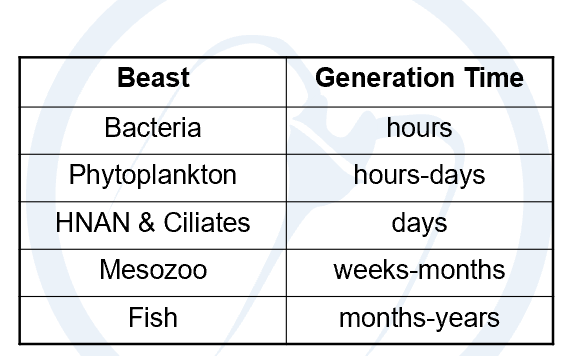
Example of miss match
Spring Diatom Bloom
-Last 1 to 2 weeks
-Copepods graze but cannot respond fast enough
-Primary production sinks to benthos
Example of match
Summer PNAN population
-Ciliate numbers respond quickly
-PNAN productivity may be high, but number remain low due to grazing by ciliates
-Primary production: Recycled within water column
What does each organism feed on:
HNAN/Large heterotrophic flagellate/Ciliates/Heterotrophic dinoflagellates/Coastal copepods
HNAN→Bacteria
Larger heterotrophic flagellates→NAN
Ciliates→NAN
Heterotrophic dinoflagellates→Diatoms
Coastal copepods→Diatoms, NAN, Ciliates
What is remineralization
Transformation of organic molecules to inorganic forms, typically mediated by biological activity
Nutrient remineralization chemical equation

Where does the uptake bacterial nutrition at cellular level goes?
Direct uptake to LMW DOM
What type of enzyme activity does bacterial nutrition at cellular level have?
Exoenzymatic activity
-Break down complex DOM and POM
What does bacterial nutrition at cellular level also require?
Inorganic molecules
What 2 factors keep bacterial population in check?
-Bacterivory
-Viral lysis
What happens when Nitrogen is limiting factor in the oceans?
Bacteria and phytoplankton compete for DIN
-Bacteria better competitor due large surface area/volume ratio
What is the most important remineraliser when competition between bacteria and phytoplankton occurs?
Protozoa
How are protozoa linked to regeneration of Nitrogen?
Protozoa incorporate majority of bacterial N
-Provides N link bacteria to mesozooplankton
-Allows N remineralisation to be dominated by mesozooplankton
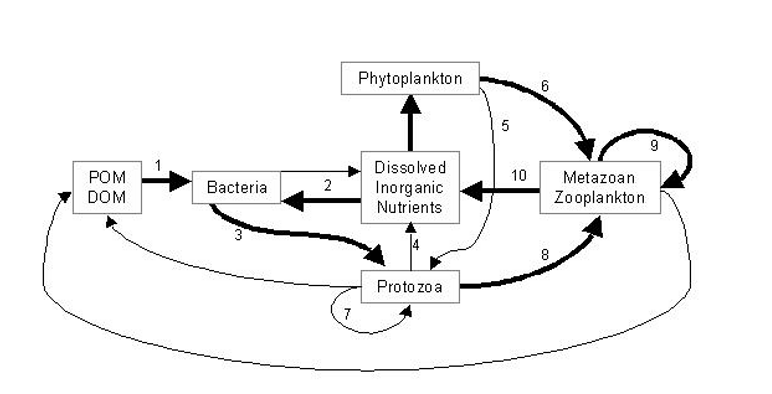
How are protozoa sinkers of Nitrogen?
Bacteria remineralise POM & DOM and protozoa remineralise remaining nutrients
-Low efficiency of transfer
-Little PON for mesozooplankton
-Microbial loop=PON sink
-Provide DIN to phytoplankton
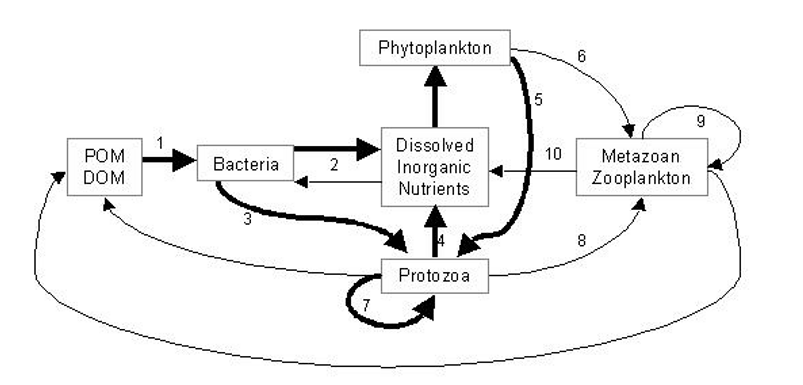
What happens if coupling between microplankton and higher organisms is weak?
Organic matter can be recycled multiples times between microbes and microplankton
-It des not move up the food chain
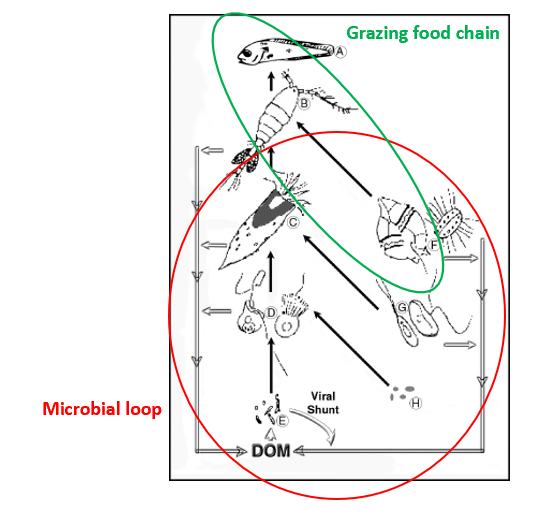
So does the microbial loop act as a PON link or sink?
Inbetween
What role do microbial loop organisms have in environments they dominate?
Important remineralisers
What is link or sink role in food quality?
C:N ratio
-Predators feeding on N rich prey will excrete excess N as NH4+
-Bacterivorous protozoa N poor compared to bacteria prey→excrete excess NH4+
-Copepods N rich compared to phytoplankton prey→Incorporate N
Food quality C:N ratio table
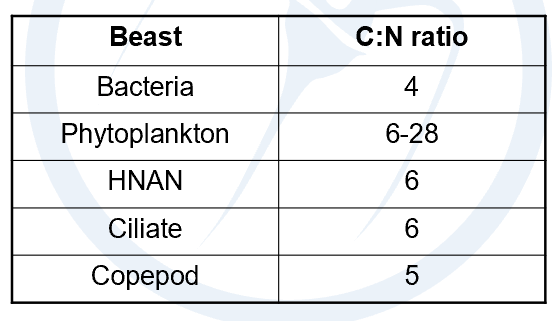
What does link or sink recycle in oligotrophic enviroments?
Recycle Nitrogen
What is the problem of link or sink?
Rates difficult to measure
What does the paper “The importance of Antarctic krill in biogeochemical cycles” show?
This study explores the biogeochemical role of Antarctic krill (Euphausia superba) in the Southern Ocean, highlighting their influence on nutrient cycling, primary productivity, and carbon sequestration.
Key points of “The importance of Antarctic krill in biogeochemical cycles”?
Nutrient Transport & Phytoplankton Fertilisation
-Antarctic krill (Euphausia superba) migrate vertically daily, redistributing iron and other nutrients from deep waters to surface ecosystems
-Fertilisation stimulates phytoplankton growth, supporting marine food webs primary productivity
Krill role in Carbon Sequestration
-Krill produce fast sinking faecal pallets, a significant contribution to the biological pump
-Their excretion helps transport organic carbon to deep ocean layers, aiding long term CO2 sequestration
Impact of Climate Change & Krill Fisheries
-Krill population are affected by ocean warming and sea ice loss, altering nutrient cycling
-Large scale krill fishing may reduce natural iron fertilisation, impacting phytoplankton productivity and carbon export
Biogeochemical Significance
-Krill link primary producers (phytoplankton) to higher trophic levels (fish, seabirds, whales) while also influencing nutrient dynamics
-Role extends beyond being prey-they actively shape marine biogeochemical processes
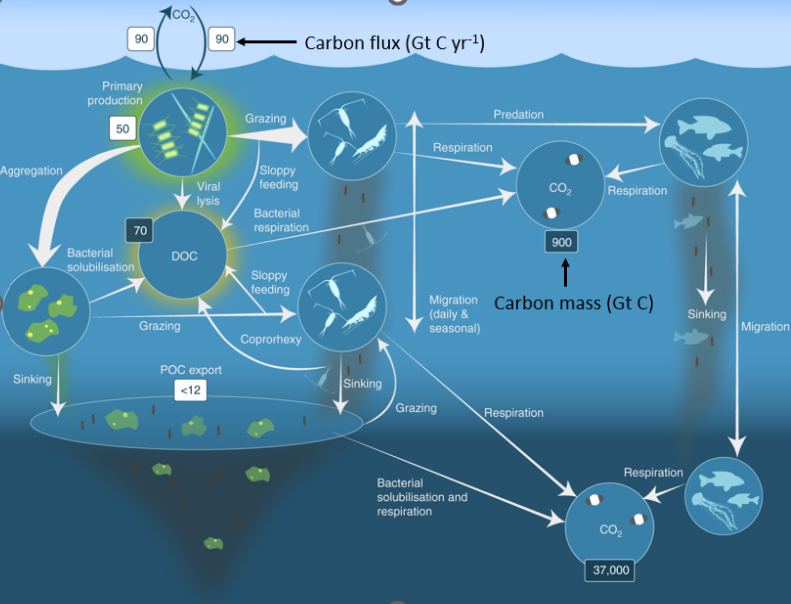
Citate “The importance of Antarctic krill in biogeochemical cycles”
Cavan et al., 2019
C Export Fluxes (%PP) table
Ocean Basin | Export at 100m | Export at >1000m |
Equatorial Pacific | 2-7 | 1 |
Arabian Sea | 5-10 (20) | 1.7 |
Southern Ocean | 30 | 3 |
-General: Low export of POC relative to PP
What are the exceptions of C export Fluxes?
Episodic events and Export pulses
Example of episodic events?
Spring blooms in North Atalntic
Example of export pulses?
SW monsoon in Arabian Sea
What is the high export and a low export
High export=Classical food chain
Low export=Microbial loop
High Export Environments features
-Large phytoplankton: Diatoms
-Large zooplankton
-High miss-match
-Major export C to deep ocean
Low Export Environments features
-Microbial loop organisms
-Dominate most of worlds oceans
-OM remineralised & recycled: SML
-V little export to deep ocean